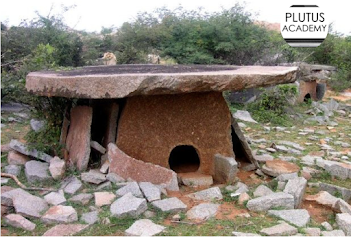Mudu Konaje Megalithic Dolmen Site Reveals Ancient Terracotta Figurines
In a recent archaeological excavation near Moodbidri in
Dakshina Kannada, a remarkable discovery has been made at the Mudu Konaje
Megalithic Dolmen Site. The site has yielded a diverse collection of terracotta
figurines, along with bone and iron fragments, providing fresh insights into
its historical significance.
Discovering the Mudu Konaje Megalithic Dolmen Site
Originally brought to attention by historian Pundikai
Ganapayya Bhat in the 1980s, the Mudu Konaje Megalithic Dolmen Site, situated
approximately 8 km from Moodbidri, was once the largest of its kind. It boasted
nine dolmens perched on the slope of a stone hill, although only two dolmens
remain intact today, with the rest having deteriorated over time.
It is important to keep yourself updated with current affairs as it
is one of the significant topics in many competitive exams, including bank exams,
SSC, etc.
Unveiling the Dolmens of Megalithic Culture
The megalithic culture in India is known for its diverse
burial practices and the utilization of iron. Among its architectural marvels
are large stone monuments, including dolmens, menhirs, and cairns. Dolmens,
characterized by large stone slabs (orthostats) arranged in a clockwise fashion
to form a square chamber, feature prominently in this culture. They are sealed
with a massive capstone and typically include a round or U-shaped entrance on
the eastern slab. In South India, these structures go by various names, such as
Kalmane, Pandavara Mane, Moriyara Mane, Moriyara Betta, and more.
Significance of Unearthed Terracotta Figurines
Among the discoveries at the site are eight terracotta
figurines, including two cow bovines, a mother goddess, two peacocks, a horse,
the hand of a mother goddess, and an unidentified object. Although these
figurines had been disturbed by treasure hunters, they hold immense historical
value. The cow bovines found within the dolmens are particularly crucial for
determining the chronology of these structures.
The presence of terracotta figurines in megalithic burials
provides valuable insights into the Bhoota cult or Daiva Aradhane of coastal
Karnataka. Remarkably, the cow goddess figurines found here draw parallels with
those discovered in Malampuzha, Kerala, and even Egypt. Radiocarbon dating
places the terracotta figurines from Mudu Konaje in the period of 800-700 BC.
With a structured bank, SSC, CUET, and IELTS coaching in Delhi from Plutus Academy will definitely raise your possibility of topping the exam or getting recruited in your most desirable job profile in the government department or other important entities.


.jpg)

Comments
Post a Comment